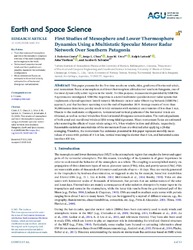First Studies of Mesosphere and Lower Thermosphere Dynamics Using a Multistatic Specular Meteor Radar Network Over Southern Patagonia
Conte, J. Federico; Chau, Jorge L.; Urco, Juan M.; Latteck, Ralph; Vierinen, Juha; Salvador, Jacobo O., 2021: First Studies of Mesosphere and Lower Thermosphere Dynamics Using a Multistatic Specular Meteor Radar Network Over Southern Patagonia. In: Earth and Space Science, Band 8, 2, DOI: 10.23689/fidgeo-4397.
 |
Dokument öffnen: |
This paper presents for the first time results on winds, tides, gradients of horizontal winds, and momentum fluxes at mesosphere and lower thermosphere altitudes over southern Patagonia, one of the most dynamically active regions in the world. For this purpose, measurements provided by SIMONe Argentina are investigated. SIMONe Argentina is a novel multistatic specular meteor radar system that implements a Spread‐spectrum Interferometric Multistatic meteor radar Observing Network (SIMONe) approach, and that has been operating since the end of September 2019. Average counts of more than 30,000 meteor detections per day result in tidal estimates with statistical uncertainties of less than 1 m/s. Thanks to the multistatic configuration, horizontal and vertical gradients of the horizontal winds are obtained, as well as vertical winds free from horizontal divergence contamination. The vertical gradients of both zonal and meridional winds exhibit strong tidal signatures. Mean momentum fluxes are estimated after removing the effects of mean winds using a 4‐h, 8‐km window in time and altitude, respectively. Reasonable statistical uncertainties of the momentum fluxes are obtained after applying a 28‐day averaging. Therefore, the momentum flux estimates presented in this paper represent monthly mean values of waves with periods of 4 h or less, vertical wavelengths shorter than 8 km, and horizontal scales less than 400 km. Key Points:
First observations of mesosphere and lower thermosphere dynamics over one of the most dynamically active regions in the world
Estimates of mean horizontal winds and their gradients are possible, thanks to the multistatic configuration
Mean momentum fluxes are estimated with vertical velocity estimates free of horizontal divergence contamination
Statistik:
ZugriffsstatistikSammlung:
This is an open access article under the terms of the Creative Commons Attribution‐NonCommercial‐NoDerivs License, which permits use and distribution in any medium, provided the original work is properly cited, the use is non‐commercial and no modifications or adaptations are made.

